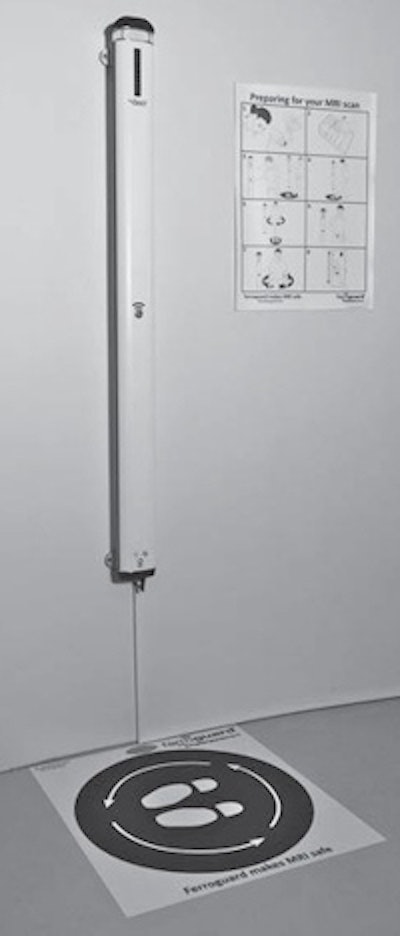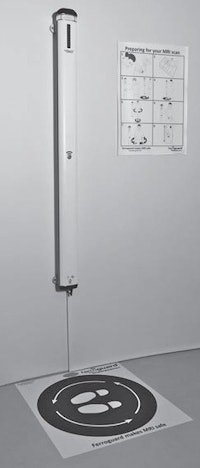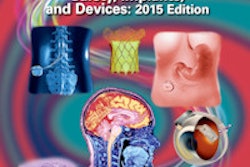
A ferromagnetic detection system ferreted out many kinds of metallic devices and objects that could typically be introduced into an MRI suite, according to a study in the October issue of the American Journal of Roentgenology. Such a system could help prevent implant-related accidents, the authors concluded.
The system detected objects ranging from armor-piercing bullets to pulse generators used to power cardiac pacemakers. While the system had more trouble detecting small metallic items, many of these might not present risks to patients anyway, according to the authors.
 The ferromagnetic detection system used in the study to locate implants and other objects on volunteers. Image courtesy of AJR.
The ferromagnetic detection system used in the study to locate implants and other objects on volunteers. Image courtesy of AJR.
"These results indicated that ... this ferromagnetic detection system may be a useful tool to screen patients referred for MRI examinations who may have implanted or embedded items," wrote lead author Frank Shellock, PhD, from the University of Southern California's Keck School of Medicine, and Alexandra Karacozoff, from Loyola Marymount University (AJR, October 2013, Vol. 201:4, pp. 720-725).
Growing number of accidents
MRI procedures have increased in recent years, as the modality has become a substitute for CT in some clinical applications to reduce radiation exposure to patients. At the same time, there was a 523% increase in MRI accidents between 2000 and 2009, according to reports filed with the U.S. Food and Drug Administration's (FDA) Manufacturer and User Facility Device Experience (MAUDE) database.
"Because of the serious risks associated with exposure of ferromagnetic implants or foreign bodies to the powerful magnetic fields of MRI systems, a critical component of screening involves using procedures to identify unsafe items that may be implanted or embedded in patients," the authors wrote. "Unfortunately, MRI screening is not always able to determine the presence of implanted objects that are potentially hazardous."
Detection technology
Shellock and Karacozoff used a vertically mounted "pillar-type" ferromagnetic detection system (Ferroguard, Metrasens) because its design allows head-to-toe scanning of a patient.
To test the system's ability to detect ferromagnetic objects, they chose 67 different implants and other items made from materials with relatively low magnetic value, such as orthopedic implants made from titanium or cobalt-chromium. Also put to the test were items known to be contraindicated for MRI examinations, such as certain cardiac pacemaker pulse generators and a ferromagnetic armor-piercing bullet. The different objects were attached to volunteers for detection.
First, the volunteers approached the device with no metal objects or material to verify the system's function. An object was then attached to a volunteer in a location that approximated its position during an MRI scan. The volunteer walked up to the front of the ferromagnetic detection system to a distance of 5 cm, rotated four times (four seconds per rotation, with a three-second delay between rotations), and walked away.
Ferromagnetic items tested
- 43 pulse generators
- 5 electronic devices
- 4 bullets
- 3 shunt valves
- 3 orthopedic implants
- 1 vascular access device
- 1 hemostatic clip
- 1 aneurysm clip
"Importantly, these implants and objects were selected with an emphasis on ferromagnetic items and because they may be present in patients referred for MRI examinations," the authors noted.
Implant detection
When the scans were completed, the researchers tallied 58 true positives, four true negatives, five false negatives, and zero false positives. The device achieved sensitivity of 92% and specificity of 100%.
The five false negatives were for implants of low magnetic content that generally would not be a hazard to patients in terms of magnetic field interactions, the authors wrote. The five false negatives did include two pulse generators associated with cardiac pacemakers that are contraindicated for MRI. Two of the five were also associated with devices classified by the FDA as appropriate for use in 1.5-tesla MRI suites under certain conditions ("MR conditional").
Overall, the ferromagnetic detection system identified 39 (91%) of 43 pulse generators used for electronically activated devices, according to Shellock and Karacozoff.
"When a positive alarm occurs, additional attention must be given to the patient to determine whether the alarm was associated with an MR conditional device," they wrote.
The ferromagnetic detection system also activated an alarm for two armor-piercing bullets, indicating its ability to detect small objects that could result in injuries to patients referred for MRI exams.
The detection system "may be a useful tool to screen patients referred for MRI examinations who may have implanted or embedded items," the authors concluded. "Thus, this information represents a potentially important means of preventing serious injuries in the MRI environment."
"Further investigation to determine the use of this ferromagnetic detection system to detect implants in the clinical MRI setting is warranted," they added. "Notably, these findings are highly specific to this particular ferromagnetic detection system along with the protocol used in this investigation."



.fFmgij6Hin.png?auto=compress%2Cformat&fit=crop&h=100&q=70&w=100)




.fFmgij6Hin.png?auto=compress%2Cformat&fit=crop&h=167&q=70&w=250)











